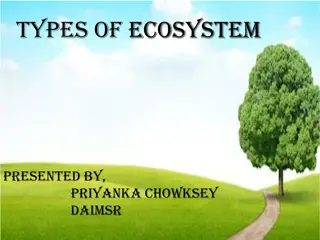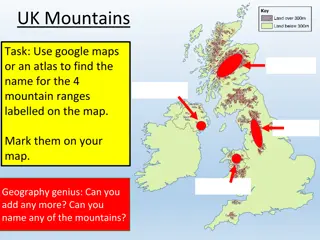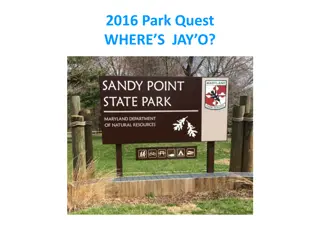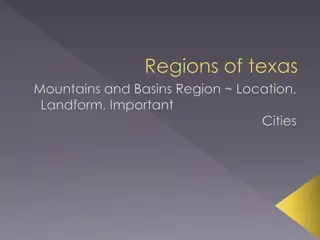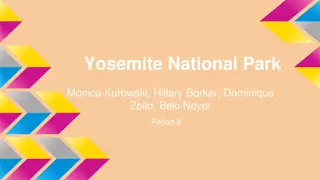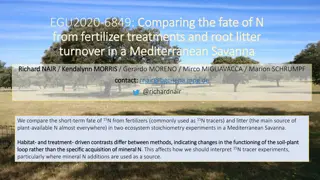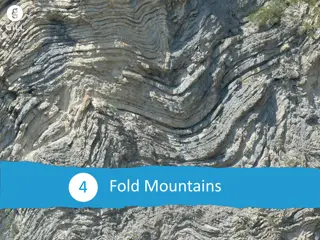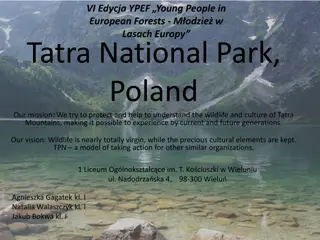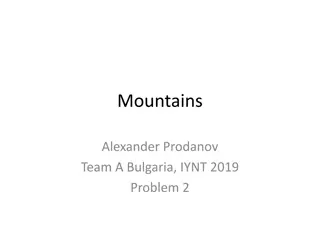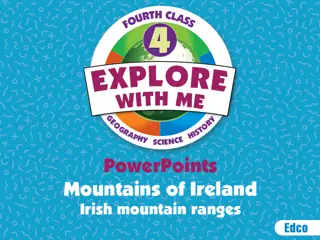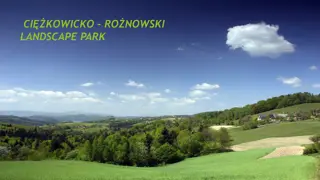Discover the Ecosystem of Debs Park: From the Mountains to the City
Explore the unique ecosystem of Debs Park, transitioning from mountain landscapes to an urban setting. Learn about key terms like biodiversity, habitat, and plant communities, with a focus on the shrubby woodland and diverse plant species found in this Californian habitat.
Download Presentation

Please find below an Image/Link to download the presentation.
The content on the website is provided AS IS for your information and personal use only. It may not be sold, licensed, or shared on other websites without obtaining consent from the author.If you encounter any issues during the download, it is possible that the publisher has removed the file from their server.
You are allowed to download the files provided on this website for personal or commercial use, subject to the condition that they are used lawfully. All files are the property of their respective owners.
The content on the website is provided AS IS for your information and personal use only. It may not be sold, licensed, or shared on other websites without obtaining consent from the author.
E N D
Presentation Transcript
From the Mountains to the City From the Mountains to the City A guide to the ecosystem of Debs Park NPS NPS 2023 2023
Key Terms to Know: Key Terms to Know: Biodiversity- the variety of life in the world or in a particular habitat or ecosystem. Ecosystem- a group of living things and the environment in which they interact. Habitat- the living place of an organism that has the things the organism needs to survive. Organism- a living thing. Plant Community- a group of plants living in a particular local area and have similar needs. Water - colorless, transparent, odorless, tasteless liquid that forms the seas, lakes, rivers, and rain and is the basis of the fluids of living organisms. Soil- a mixture of minerals, water, air, organic matter, and organisms that decay remains of once- living things. Elevation- distance from sea level Aspect- the compass direction that a slope faces. NPS NPS 2023 2023 2
Plant Community: Shrubby Woodland Plant Community: Shrubby Woodland The shrubby woodland of Debs Park is an important component of California s Mediterranean-type vegetation, which is under significant pressure due to development and climate change. In some ways Debs Park is like an island of habitat, surrounded by homes, roads and people. N N P P S S 2 2 0 0 2 2 3 3 This short, open woodland is home to shrubs and trees such as Southern California Black Walnut, Toyon, and Coast Live Oak. On the lower level plants as Poison Oak and Laurel Sumac can be found. These plants provide habitat for local wildlife such as Scrub Jays, Grey Squirrels, and deer! 3
Plants you will find Plants you will find Black Sage Coast Live Oak Laurel Sumac Poison Oak Southern California Black Walnut Toyon NPS NPS 2023 2023 4
Black Sage Black Sage Where is it likely to grow: flats, foothills, canyons, shallow slopes, slope bottoms. It is a shrub. NPS NPS 2023 2023 5
Black Sage Black Sage Flowers from March to July Seeds are tiny and are stored in seed pod like balls. How do animals use it: important food source for butterflies and birds such as the hummingbird. NPS NPS 2023 2023 6
Coast Live Oak Coast Live Oak Where they like to grow: found on shady, north-facing slopes, and along upper terraces. Coast Live Oaks are a species of tree. NPS NPS 2023 2023 7
Coast Live Oak Coast Live Oak Flowers Flowers mid to early spring. Acorns are the kind of fruit an Oak tree produces. A nut is a kind of fruit. Inside of the nut is the seed. How animals use this: Birds like Western Scrub Jays and Nuttalls Woodpeckers will eat acorns. Other birds build their nests in Oaks. Acorns NPS NPS 2023 2023 8
Southern California Black Walnut Full view Where is it likely to grow: slopes, canyons, valleys, often near stream beds or washes. It is a tree. Leaves NPS NPS 2023 2023
Southern California Black Walnut Flowers Flowers January through Spring. Walnuts are a kind of fruit. Inside the shell is the seed, or nut. How do animals use it: Animals, such as Owls, will build their nests in the tops of tall trees. Grey squirrels and birds like to eat the walnuts. Bird Nest Walnuts NPS NPS 2023 2023
Toyon Full view Where is it likely to grow: creeksides, bottom of slopes, north facing slopes, canyons. It is a shrub. Leaves NPS NPS 2023 2023
Toyon Flowers Flowers in early summer Fruit: small, red berries that grow in fall through winter. Seeds are inside berries. How do animals use it: butterflies often visit it. Birds and coyotes eat the berries. Berries NPS NPS 2023 2023
Black Sage Full view Where is it likely to grow: flats, foothills, canyons, shallow slopes, slope bottoms. It is a shrub. Leaves NPS NPS 2023 2023
Black Sage Flowers from March to July Seeds are tiny and are stored in seed pod like balls. How do animals use it: important food source for butterflies and birds such as the hummingbird. Flowers Seed pods Seeds NPS NPS 2023 2023
Laurel Sumac Laurel Sumac Where is it likely to grow: commonly found on dry ridges and canyon slopes. It is a shrub. Full view NPS NPS 2023 2023
Flowers Laurel Sumac Laurel Sumac Flowers in early Summer. Fruit are small round berries. At first a deep red-purple that turns white over time. How do animals use it: The berries serve as a food source for birds and mammals like deer. Birds can build nests on branches. Animals benefit from the shade it provides. Fruit NPS NPS 2023 2023
Poison Oak Where is it likely to grow: widely distributed causes itching and allergic rash for many. It is a shrub. Full view Leaves Leaves of three, leave it be NPS NPS 2023 2023
Poison Oak Flowers March to June Fruit tiny berries form in summer Leaves change color and drop in fall How do animals use it: many animals, such as deer and squirrels, eat the leaves. Birds eat the berries and use branches for shelter Fruit NPS NPS 2023 2023
Birds you will find Scrub Jay Nuttall s Woodpecker Anna s Hummingbird California Towhee Yellow Rumped Warbler White-Crowned Sparrow NPS NPS 2023 2023
California Scrub Jay Where I like to hang out:You ll often notice me silhouetted high in trees, on wires, or on posts where I act as lookouts. I like open habitats like woodlands, as well as backyards. Beaks: The beak of a California Scrub-Jay is stout and hooked, giving it extra power and grip as the birds hammer open acorns in their oak woodland habitats. Nests: Scrub-jay nests are made of a basket of twigs lined with rootlets, fine strands of plant fibers, and livestock hair. Native or Visiting? You can see California Scrub Jays year around. http://www.audubon.org/field-guide/bird/california-scrub-jay Photo credit: Garth McElroy/VIREO; Brian E. Small/VIREO NPS NPS 2023 2023
Nuttalls Woodpecker Where I like to hang out: You are most likely to see me hitched up branches and twigs of oaks or picking insects out of crevices in tree trunks and branches. Beaks: I spend most of my time in oak woodlands but I do not eat acorns. I like to eat insects, such as beetles, beetle larvae, ants, termites, and millipedes found on oaks and other trees. I use my pointed beak to probe into tree bark to reach insects or pick them off bark or vegetation. I sometimes like to eat berries from poison oak and toyon. Nests: The male chips away at trunks or limbs of trees, like Coast Live Oaks, to create a hole with an entrance that is about 2 inches wide. They create a new hole each year. Native or Visiting? You can see Nuttall s Woodpecker year around. http://www.audubon.org/field-guide/bird/nuttalls-woodpecker Photo credit: Paul Bannick/Vireo; Joe Fuhrman NPS NPS 2023 2023
Annas Hummingbird Where I like to hang out: Sometimes, I look more like a blur of motion as I hover before flowers looking for nectar and insects. I am commonly found in yards, parks, residential streets, eucalyptus groves, riverside woods, savannas, and coastal scrub. Beaks: My long, thin beak is perfect for eating nectar from flowering plants like Chaparral Honeysuckle and Black Sage. I have also been known to eat insects and tree sap. Nests: The female builds the nest out of plants and spider webs, sitting in the nest and building the cup rim up around her. They may decorate the outside with lichens, mosses, or even paint chips. They often build nests in oak or other trees, but they may also use vines, shrubs or even poison oak. Native or Visiting? You can see Anna s Hummingbirds year around. http://www.audubon.org/field-guide/bird/annas-hummingbird Photo credit: Rick and Nora Bowers; Hugh P. Smith, Jr. & Susan C. Smith NPS NPS 2023 2023
California Towhee Where I like to hang out: You can see me hopping or running on the ground but I tend to stay close to the protection of low shrubs and trees. You ll find me in chaparral and other tangled, shrubby, and dry habitats. Beaks: My thick pointy beak is great for cracking open seeds of grasses and other plants, however I have been known to like eat fruits like toyon, poison oak, and acorns. I will also eat insects (mostly beetles and grasshoppers). Nests: California Towhees typically build their nests in a low fork (3-12 feet high) in a shrub or small tree. Females build the nest while the male watches. She typically works on the nest in the morning, weaving an outer cup from twigs, grasses, dried flowers, and sometimes trash such as plastic ribbons. This she lines with animal hair, strips of sagebrush bark, and downy seeds. Many towhees build their nests in poison oak and feast on the plant s copious crops of pale white berries. Native or Visiting? You can see California Towhees year around. http://www.audubon.org/field-guide/bird/california-towhee Photo credit: Rick and Nora Bowers/VIREO NPS NPS 2023 2023
Yellow Rumped Warbler Where I like to hang out: In summer, I like to hang out in open coniferous forests. In fall and winter, I migrate to open woods and shrubby habitats, such as coastal vegetation, parks and residential areas. Beaks: My sturdy beak is great for eating insects. I often cling to bark while hunting for bugs, but am also known to catch a passing insect while sitting on branches. I also eat fruits, and have a unique ability to digest waxy fruits. Nests: Females build the nest on horizontal branches 4-50 ft up in a tree. They use twigs, pine needles, grasses and rootlets to form a cup. Nests are often lined with fine animal hair and feathers. It takes me 10 days to build. Native or Visiting? I visit in the fall and winter. http://www.audubon.org/field-guide/bird/yellow-rumped-warbler Photo credit: Laure W. Neish; Richard Crossley NPS NPS 2023 2023
White-Crowned Sparrow Where I like to hang out: I like to hang out in the safety of tangles of brush mixed with open or grassy ground for foraging. I can often be found hopping on the ground or on branches Beaks: My small bill is perfect for eating seeds from weeds and grasses. However, I also like to eat caterpillars, wasps, beetles, fruit, and grains. Nests: Females build nests low in shrubs Native or Visiting? I like to spend my winters in southern California, but in the summer you ll see in the mountains! http://www.audubon.org/field-guide/bird/white-crowned-sparrow Photo credit: Glenn Bartley/VIREO, Hugh P. Smith, Jr. & Susan C. Smith/VIREO NPS NPS 2023 2023
Thank you NPS NPS 2023 2023 26


